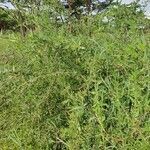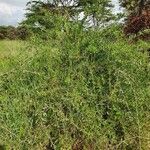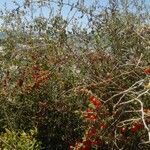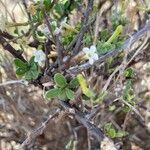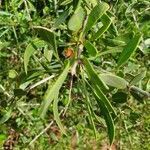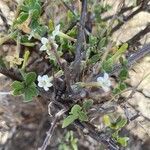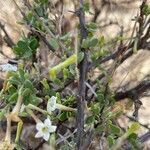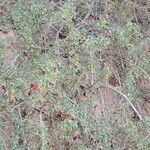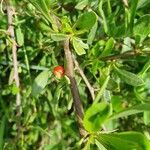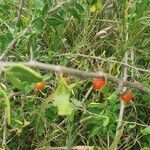Corolla creamy-white to pale mauve with purple venation, (10)12–16 mm long, glabrous outside; tube narrowly tubular, sometimes slightly curved, glabrous to sparsely pilose on the inside just below filament insertions; limb 7–11 mm across, creamy-white to pale mauve; lobes (1.5)3–4 mm long, semi-ovate-oblong, spreading, sparsely ciliate.
A thorny shrub. It grows 1.5 m high. It loses its leaves during drought. The leaves are spoon shaped and leathery. They are 2-3.5 cm long by 1 cm wide. The flowers can be pink, blue or white. They are on stalks in the axils of leaves. The fruit are orange-red berries. They are edible.
Stems slightly angular, robust; long branches slightly curving, sometimes pendulous; spines 5–10(15) mm long, leafless except when occurring on very old stems; bark greyish-white to dark ash-grey, seldom dark brown to purplish-brown; brachyblasts greyish-white.
Shrub, up to 2 m high. Leaves and young branches glabrous. Leaves linear-lanceolate to ovate-spathulate, 1.5-4.0 times as long as broad. Peduncles 4 mm long not exserted, filaments glabrous. Flowers white or mauve.
Erect, spreading, sometimes scandent, intricately branched, very spiny shrub 1–2.5(3) m high, infrequently a small tree up to 4.5 m, glabrous.
Stamens unequal, attached above the middle of the corolla tube, 3 included and 2 slightly exserted; filaments (3)4–7(9) mm long, glabrous.
Calyx 3–5 mm long, glabrous; tube narrowly tubular, 1.5–2 mm wide; lobes equal, 0.4–0.6 mm long, triangular, slightly acute, erect.
Ovary 1.5–2 × 1.5 mm, globose; style 10–12 mm long and just shorter than the longest stamen.
Fruit red, 3–5 mm in diameter, globose to slightly obovoid, apparently edible.
Flowers hermaphrodite, 5-merous, pendulous; pedicels (1)6–8 mm long.
Disk inconspicuous, pale brownish-yellow.
Seeds 2 × 1.5 mm, ovate in outline.
